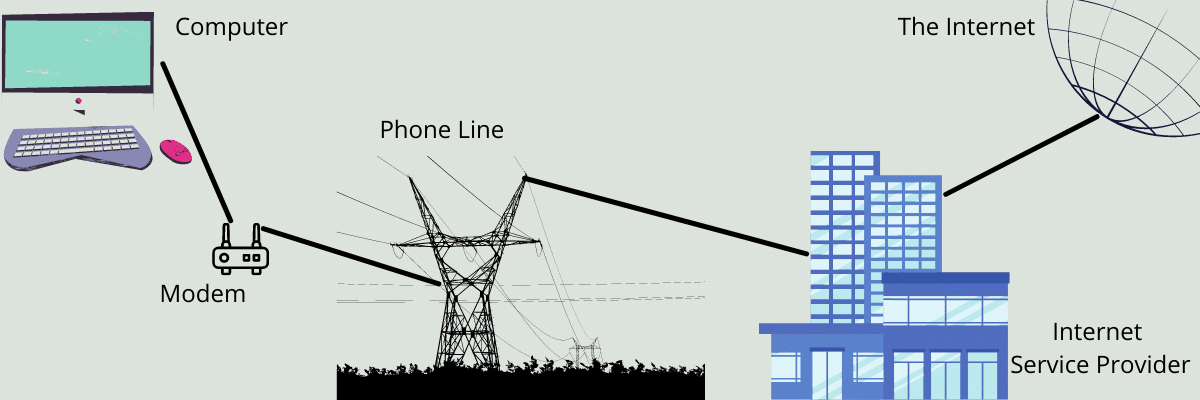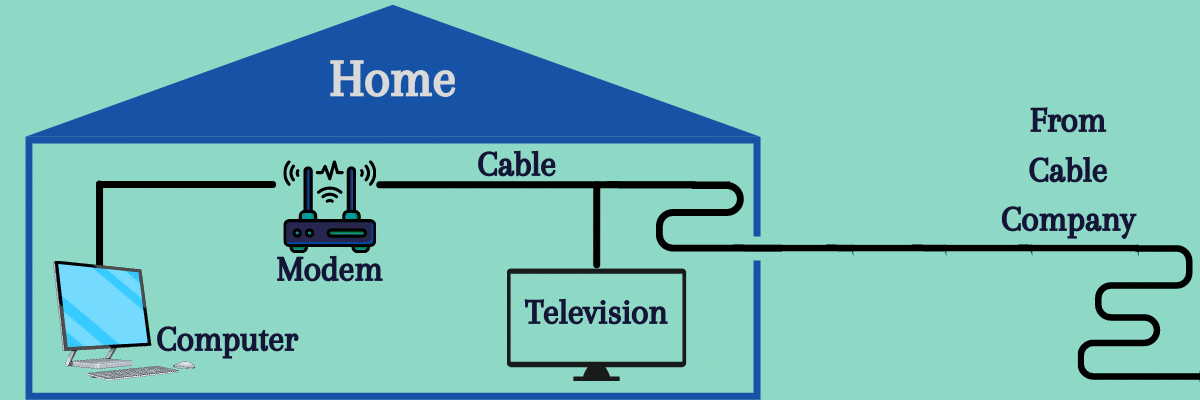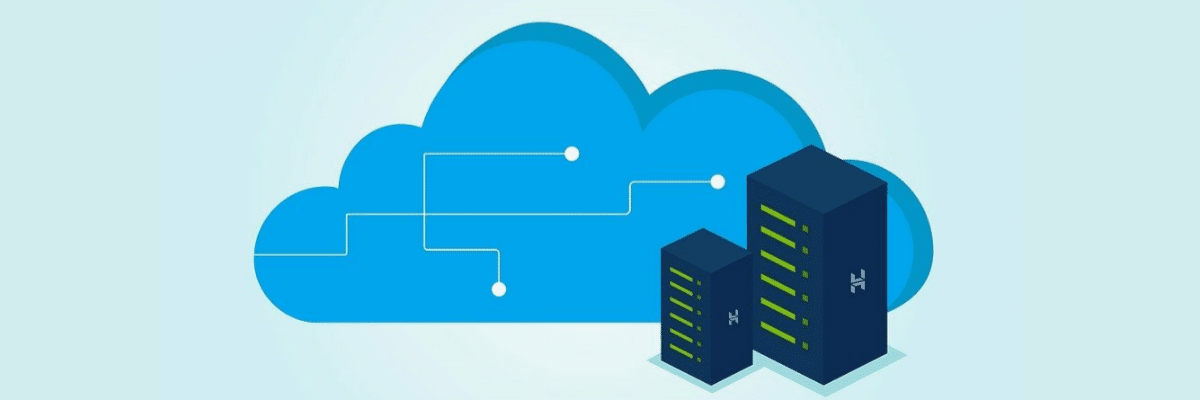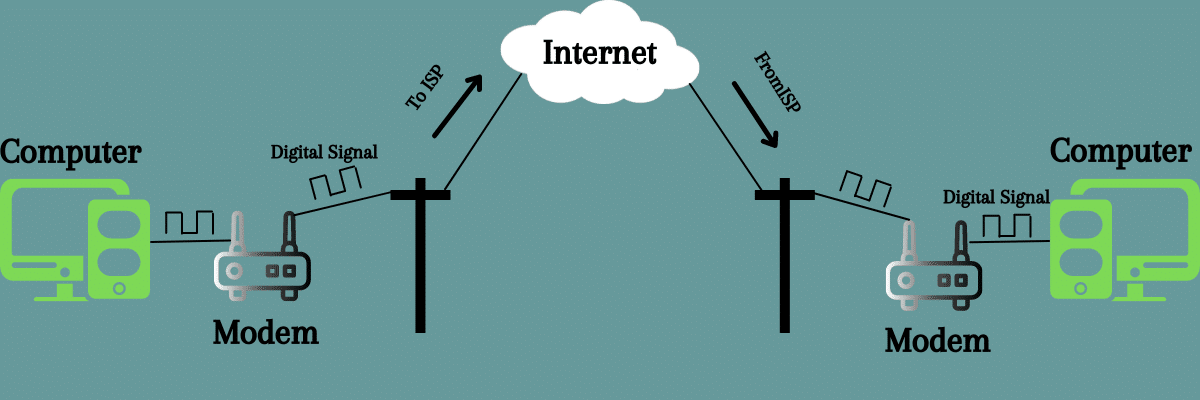An Internet Service Provider (ISP) is like an unsung hero that provides all the capabilities to make your internet life easier, whether you want to use Facebook, shop something on Amazon, play Minecraft with your friend living in the other half of the globe, or doing video conferencing with that client from abroad.
The internet is the magic that provides a lot of opportunities and fun, but ISPs are the wizards that make all this possible for you.
Whether you are a business using stable connectivity for your operations, a student researching on the web, or an individual sitting on your comfy couch and watching cat videos all day long, thank your ISP for providing you with hassle-free internet life.
In this article, we’ll learn all about what ISPs are and how they work. We’ll also talk about why you need them in the first place and how to go about choosing the right ISP for you.
So, without further ado, let’s get started!
What Is an ISP?

An Internet Service Provider (ISP) refers to an organization that offers various services to enable users to access and use the internet. ISPs can be privately owned, community-owned, commercial, or non-profit organizations. They offer common services, such as internet access, web hosting, internet transit, email services, proxy servers, colocation, domain name registrations, and more.
In a nutshell, without an ISP, you won’t be able to use the internet and do all the cool stuff you enjoy, like playing online video games, using social media, shopping online, etc. — or managing your business’s activities, for that matter.
What Are the Top Examples of ISPs?
Some of the top ISP providers in the US are:
- AT&T: AT&T is one of the biggest ISPs in the US, offering high-speed internet services to millions of customers in many states. It offers Digital Subscriber Line (DSL) broadband, fixed, and fiber wireless internet service.
- Verizon: Verizon is among the first ISPs that offered fiber optic internet services. Its presence is in various US states serving over 30 million customers. It also offers DSL services with fast internet speeds.
- Xfinity: Xfinity offers internet, cable TV, wireless, and telephone services. About 50+ million people living in around 40 states use Xfinity for their businesses and homes. It provides extraordinary fast internet service ranging from 20 Mbps to hundreds.
- Spectrum Internet: Introduced quite recently in 2014, this ISP serves 25+ million consumers from around 41 states. It offers a variety of fiber and broadband services both for commercial and residential purposes.
- CenturyLink: Around 52 million people from 36 states use CenturyLink for its internet services like DSL, fiber-based internet, etc. It also offers bundled services with DIRECTV so that you can avail of the complete package.
Other providers in the US are Frontier, Cox, Sparklight, Mediacom, Windstream, Earthlink, and more.
Where ISPs Came From
The internet was initially developed to be used by governments and some university departments for research. Eventually, these entities started giving access to their faculties and staff, and other organizations and companies also joined by indirect and direct links.
By the 1980s, efforts were made to make the internet available for commercial and public use. Regulators removed some restrictions on internet usage by 1991, and the general public could access it via the World Wide Web.
In the beginning, only a few ISPs, such as America Online (AOL), were around, and they provided limited access through dial-up connections utilizing phone lines. Gradually, connectivity speeds and options increased to birth the internet economy using advanced technologies like broadband via cables and DSL modems until in 1995, internet usage restrictions were finally removed from commercial traffic.
Types of ISPs
Back in the 90s, ISPs were one of three types: dial-up services, DSL by phone providers, and broadband by cable companies. Over the following two decades, though, dial-ups grew rarer, owing to low speed, while other options flourished.
Let’s look at the different types of ISPs available today.
Dial-Up Internet Providers

Dial-up internet uses your current phone line to connect you to the internet. To establish connectivity, it requires you to dial an access number (similar to a phone number) with a modem. When you are online, you can’t make a phone call with your number, unlike with a DSL connection.
Dial-up is easily accessible via landline, and it’s secure and cost-efficient. However, it’s very slow — 56 kbps is the maximum internet speed you can attain with it. Given the advanced technologies we use today, this speed is not sufficient for most operations, especially as some web pages or apps will show trouble loading and may time out before they load.
This is why people are shifting to other options. According to a 2021 Statista report, only 1.9% of households used dial-ups in the US. It’s used in some rural areas with no broadband availability, but it’s been otherwise abandoned.
DSL Providers
Digital Subscriber Line (DSL) enables internet connection through a telephone line. The services are widely available because houses are wired for phone connections already. It’s provided by traditional phone companies.
The DSL technology leverages extra signals that telephone signals don’t use. It utilizes a DSL router to connect to a telephone jack through a phone cable. These capabilities enable the users to use the internet even when using their telephones or the telephone is ringing.
DSL is not shared among the users and can be the best option if you don’t have other options accessible at your place. It offers average internet speed and does not require you to invest in expensive equipment. Just buy a modem, and your telephone connection will enable you to connect to the internet. So, when you buy a DSL connection, make sure you are close enough to the service provider because the speed affects distance.
According to another Statista report published last year, around 57% of US consumers use broadband such as DSL and cable, making it the most popular option.
Broadband Cable Providers

Cable TV companies generally offer broadband cable services. Broadband cables use coaxial cables, which deliver cable TV to homes. The service providers also offer internet services that are reliable and fast to help you perform a variety of operations at home or office. You may achieve internet speeds from one to a hundred Mbps.
The benefit of using broadband cables is they involve low latencies, which doesn’t affect you much. You may experience fewer lag times while performing certain actions like opening a website, watching a video, or playing an online video game.
Due to their wide availability, broadband cables are popular among internet users. You can also refer to the above statistic, where more than 50% of consumers use it to connect to the internet. However, these services also depend upon your geographic location. It’s shared by different users in your neighborhood, and the bandwidth allotted is distributed between everyone. So, the fewer users or traffic coming from them, the faster the internet connection will be.
Using a broadband cable gives you the option to save some money by allowing you to bundle your services, like the internet and cable TV.
Fiber Internet Providers
The internet connection leveraging the technology of fiber optics is the fastest internet service. The ISPs offering this service use fiber-optic cables created from glass strands for data transmission at the speed of light. It does not use copper. The reason for using fiber are numerous — it’s a medium to transmit light and results in qualities like:
- Immunity from electromagnetic interference
- High bandwidth capability like gigabytes per second
- Higher transmission signals of a maximum of 150 miles
- Consistency and reliability
Fiber offers the maximum speed and lowest latencies while using the internet. You can expect to experience few delays while playing games online, doing video conferencing, streaming videos, and so on. Fiber connection is built to support heavy internet usage, with maximum bandwidth and support to allow users to stream videos simultaneously, share large files, and use IoT devices at home or office.
At present, new advancements are being made, such as establishing connections between countries via fiber optics running along the ocean bed for incredible speeds without interference. However, this type of connectivity is expensive, so there are fewer areas and establishments where fiber-optics connectivity is enabled.
In addition, many areas are still not wired to help this technology reach consumers. Since it’s a relatively new concept, efforts are made to increase its availability through satellite dishes.
A popular example of fiber-optics connectivity is Google Fiber, offering a full gigabyte of bandwidth at a similar price as many DSL and cable providers. A 2021 report says that fiber usage has exceeded 30% of broadband subscriptions in many countries.
Satellite Internet Providers

Satellite internet service providers utilize geostationary satellites for data transmission between the internet and users.
Since data travels from space to earth — a distance of 22,000 miles — these high distances may cause considerable delays. In fact, satellite internet offers the highest response delays among all the other types of connectivity. In addition, speed can be severely impacted by weather conditions. Speed is also dependent upon network congestion, or how busy a network is at a particular time.
Another drawback with satellite is that you can constantly be disturbed by limited bandwidth. It won’t be sufficiently reliable if you want consistent connectivity to conduct your business process or play online games.
However, it’s the only hope for many people in rural areas, deserts, mountainous places, and farms who want relatively high speeds. It’s a better option than mobile internet and dial-ups. Although it’s not that fast compared to other types of connectivity, the benefit is that it poses fewer environmental impacts and offers greater location flexibility. (It’s also a great option for recovery centers after a natural calamity.)
Wi-Fi Providers
Another type of ISP provider is the one that offers Wi-Fi connections. Multiple users can access Wi-Fi connectivity with ease and flexibility like nowhere else because a modem isn’t required. Using Wi-Fi gives you the option to move around while staying connected. Nowadays, you can get Wi-Fi connections using a small pocket device that you can carry anywhere and work with much independence.
Moreover, Wi-Fi is also offered by governments, hotels, restaurants, and train stations freely in various parts of the world. This allows internet access to larger masses and helps people who can’t afford internet plans.
Access Providers
Access providers offer internet access by using various technologies to establish the connection for the users. They may use computer modems, fiber optics, TV cables, and telephone lines. Small businesses and individuals can use traditional options like copper wires for dial-ups, cable modems, asymmetric digital subscriber line (ADSL), etc.
For large and medium-sized organizations with consistent, high-speed internet needs, access provider ISPs offer ethernet, faster DSLs, synchronous optical networking (SONET), and more. In addition, they can also use satellite internet connections for disaster recovery, wireless access, etc.
Hosting ISPs

Web hosting companies can act as an ISP to offer services like web hosting solutions, online storage systems, email providers, cloud solutions, server operations, virtual servers, and more. Numerous hosting providers are available, such as Kinsta, offering exceptional performance, speed, scalability, and flexibility.
Mailbox Providers
Mailbox providers offer services to host email domains with storage access for mails. They offer email servers for sending, receiving, accepting, and storing emails for organizations and individuals.
Transit IPs
There are different levels of ISP providers. Upstream ISPs have larger networks than contracting ISPs, which provide access to contracting ISPs that can’t access parts of the internet by themselves. It works similarly to how customers pay for internet access: Contracting ISPs pay upstream ISPs.
The different levels are:
- Tier 1
- Tier 2
- Tier 3
- Networks
- ISPs
Virtual ISPs
Virtual ISPs (VISP) buy services from other ISPs (or wholesale ISPs). They allow the VISP’s customers to use the internet operated and owned by the wholesale ISP.
VISP can be local exchange carriers to enable voice communication or mobile virtual network operators.
How Do ISPs Work?

As discussed above, there are different tiers in ISPs. Let’s understand better what they are and how they operate to provide internet services to the end-users.
- The topmost ISPs are Tier 1, with access to the entire networks the internet can have through peering agreements. They connect every corner of the internet, and some of their examples are popular ISPs such as Verizon, Deutsch Telekom, and Bharti.
- Tier 1 ISPs sell their network access to the next tier, i.e., Tier 2. Homes, individuals, businesses, etc. can buy internet access from Tier 2. However, Tier 1 ISO might also choose to sell the end-users internet access.
- An intermediary ISP — Tier 3 ISP can also exist that may buy network bandwidth from its upper-level ISP (Tier 2 ISP) and then sell it to the end-users.
Think of an ISP as a gateway or access point that provides internet access to users, typically for a certain fee. This is how all the providers work with each other to serve internet access to consumers.
Now, let’s understand what really cooks inside.
When the internet traffic travels from your home or organizational network to reach its destination for information, it encounters lots of hops. It may route from a modem to a Tier 3 network, a Tier 2 network, and a Tier 1 network. After fetching the information, it again goes back through different ISPs before reaching its destination.
To establish connectivity, ISPs use various technologies — cables, telephone lines, DSL, satellite, fiber optics, and Wi-Fi, among others.
Now, end-users must have a modem and an active account to establish a connection to their internet providers. Modems have cable outlets or a telephone line to connect to the ISPs.
So, upon verifying your account, your ISP will assign an IP address that will be unique for your modem. Thus, you will be given internet access, and you can enjoy exploring the web for your personal or professional use.
The Role of an ISP
Whether you have a business to run or just want to explore the internet for fun, a steady, reliable internet connection is all you need. Your smartphone, laptop, business devices, IoT devices at home — everything needs you to have an internet connection, which is provided by none other than ISPs.
And ISPs make this simpler by doing all the background work so that you have a trouble-free internet connection, of course by paying some money, at least in most of the cases. They help you provide an excellent customer experience when they visit your site to browse for your products or services, buy something, or read your articles. All these help you drive your business.
Let’s look at the benefits you can expect from an internet service provider.
Stronger Network Security

Cybersecurity issues are rising faster than ever. Bad actors’ tactics are rapidly changing and advancing; hence, using a secure connection by a reputed ISP helps you secure your network and all your data.
Top ISPs use strong security mechanisms like encryptions, privacy policies, monitoring capabilities, and so on. The features and capabilities vary from ISP to ISP.
Higher Bandwidth
You need sufficient bandwidth to support all your business operations. Plus, it needs to be faster. These two are important aspects even for personal use. Taking internet service from a good ISP will offer you enough bandwidth and speed to help you accelerate your business processes while saving you hassles while you watch your favorite shows online.
Wide Range of Options
Internet service providers offer a variety of services to their customers so that they can choose the plans based on their requirements, such as personal or business use. If you have a business, you need a robust plan with high-speed connections and bandwidth so that you can choose similar plans based on your business size, large, medium-sized, or small. However, if you need it for personal use, you will also get various plans to choose from.
Reliable Network
Using an internet connection from a good ISP doesn’t let you or your customers down due to frequent downtimes, response delays, or lags. You will get higher uptime and smooth connectivity that is reliable to support your business, delight your customers, and offer you a trouble-free experience to explore the internet. They also have automatic failover systems that can reroute traffic if one of the links is down.
Drives Business
By offering a consistent, smooth experience to your customers, you can serve your customers better. It will drive your business through sales, revenue, and customer loyalty toward your brand. Your employees will also find it easier to work and deliver on quick turnaround times; you might even witness an increased rate in productivity.
ISP Glossary: Some Common ISP Terms
In the world of ISPs, there are some frequently used terms that you must be aware of if you want to have a better understanding of the concept.
- Broadband: You can use this internet service at any time because it’s always running. Its download speed is a minimum of 25 Mbps, while upload speed is a minimum of 3 Mbps.
- Wi-Fi: Wireless network is an internet connection that enables you to connect your devices, such as smartphones, laptops, tablets, virtual assistants, etc., to the internet. It’s created with the help of a router with radio waves.
- Bandwidth: This is the amount of data transmitted by a network at a time.
- Packet: Data moves via the internet in “packets.” If the packets fail to reach their destination, it’s called packet loss, resulting in lags and reduced speeds.
- Data cap: Your internet service plan will have a limitation on a certain amount of data per month. Some of the plans can also have unlimited data.
- Bundle: If you take multiple services from an ISP such as the internet connection and cable TV connection, they’ll often group those services in payment, forming a “bundle.” Other services you can bundle could be Voice over Internet Protocol phone (VolP), home automation, increased security protocols, etc.
- ADSL: Asymmetrical Digital Subscriber Line (ADSL) is a DSL service for residential usage. It comes with faster upload and download speeds.
- SDSL: This is a DSL for businesses and features equal upload and download speeds. It allows organizations to accelerate their processes, such as cloud backups, running operations, and more.
- Consistency: Consistency refers to how reliable an ISP’s internet services are in terms of their speed during high usage.
- Download speed: When you search for something on the internet, stream videos, play games, browse web pages, play music, etc., you are essentially downloading data. The speed at which you can download this information is your download speed.
- Upload speed: This is the speed at which information is sent via the internet, such as when you send a picture to a friend or colleague.
- Latency: This is the delay a user can experience when requesting some information from the internet, like when they load a webpage.
- Mbps, Kbps, Gbps: Megabits per second (Mbps) is the unit of measurement for uploading and downloading speeds in seconds when data moves via a network. 1 Mbps is 1000 kbps or kilobits per second, and 1000 Mbps equals 1 Gigabit per second (Gbps).
- Hot Spot: This type of internet connection covers smaller areas.
- Modem: This stands for Modulator-Demodulator — the electronic equipment to interact with the internet, enabling data transmission using a computer, smartphone, or other digital devices. It can be used inside the same device that has a router.
- Router: This connects you to a modem and utilizes radio waves to enable a wireless network.
- VoIP: Voice over protocol (VolP) is a technology or app that allows you to make phone calls or answer them using a broadband service rather than a telephone line.
- Throttling: This is an event that occurs when your internet provider reduces the speed of your internet connection on purpose. It can be due to many reasons such as:
- Reaching your data cap
- High data usage during peak times like evenings, weekends, and holidays
- If the ISP suspects an illegal activity like file sharing, torrenting, etc.
- The ISP chooses to reduce a site’s speed (for instance, a streamlining platform), often to maximize communal bandwidth
How To Choose a Good ISP
To have an excellent internet connection and service, you must choose an ISP mindfully. Here are some of the points to pay attention to.
Connection Type
The type of internet connection is the first thing you must consider when you are choosing an ISP. As discussed above, ISPs are of different types, offering different types of internet connectivity such as broadband, fiber-optics, cable, dial-ups, satellite, DSL, copper-based, wireless, and so on.
If you require incredibly high speeds, you can go for fiber or broadband over cable or copper. However, you will have to confirm it’s supported in your area, which is what we’ll be going to discuss next.
Availability
If you’re in an urban area, you’re free to choose just about any connectivity based on your usage, budget, and requirements.
However, if you hail from a rural area, the choice is unfortunately limited as of now. Availability will be important to research before finalizing an ISP choice.
Check what type of internet connection is available in your area. Homes and businesses in rural areas have few options like some broadband connections from companies such as Xfinity and AT&T, satellite connectivity, 4G-LTE network, and even dial-ups.
So, check what’s available in your areas, and then go for a reputed ISP based on your needs.
Speed

The next important consideration is speed. If you run a business, you need outstanding speed to ensure all your operations, systems, and services are running smoothly at all times. The right ISP will ensure your cloud backup service is always on so that you don’t lose any data owing to an unexpected outage
Speed again depends on your geographical location. Urban consumers might even touch thousands of Mbps, while rural consumers might be stuck on a few Mbps.
So, don’t just look at the advertised speed and bandwidth in your plan; test it yourself. You can carry speed tests to ensure how much speed you can expect in your area before you pay hefty sums to the wrong provider and end up disappointed.
Furthermore, enquire about the upload and download speeds, as they are different. If you run a business, you need both your upload and download speeds to be high. This will enable you to browse the web as well as share information, make changes to your site or app, join video conferencing, etc., at a faster speed.
However, if you are an individual user using the internet for recreational purposes, you might look for higher download speeds than upload, as you’ll probably need more speed for downloading information via browsing the internet, playing games, streaming videos, etc. than you will for sending information yourself.
Cost
Cost is always a deciding factor when you invest in something. If you’re a small business or an individual consumer, you can look for affordable plans that can give you sufficient bandwidth and speed to carry out your work.
However, if you’re a large business and need a high-speed connection all the time to fuel your operations, having a robust network, bandwidth, and speed will suit you the best. If you fall in this category, look for the best providers who can offer a similar service, though be aware that this will likely carry a higher price tag
To make the best choice, compare the pricing and features of different ISPs available in your areas, offering the type of connectivity you need. Choose the one that strikes the best balance between its pricing and features.
Clarity of Service
Apart from those, having an internet connection from a reputed ISP will have clear-cut Service Level Agreements (SLAs) to define ISP’s responsibility and what to expect and what not to. It saves you from confusion or friction. They will outline things like:
- Establishing upload and download speeds
- Ensuring no persistent delays happen in service deliveries
- Testing packet transmission speeds
- Securing the network
- Restricting what you must not do on the network
- Clear payment terms
- The time when they may cut off your services
- Protocols to restore services
And more…
A service level agreement (SLA) establishes an agreement between you and your service provider. It will outline all the necessary details of your service, such as uptime, packet loss, latency, response time, etc. This increases the transparency between both parties and tells you what services you will get without any hidden agenda from the service provider.
However, many companies don’t provide that. And if you take services from such companies, you may end up paying more than you were asked initially. They may ask for hidden charges, service binds, or other surprises that you did not sign up for.
Hence, always look for service level agreements, read them carefully, and then go ahead with buying services from them.
FUP
Fair Usage Policy (FUP) is a common term that you might have faced yourself. It has to do with the fair sharing of internet connectivity resources.
Have you ever felt your internet speed reduced after consuming a high data volume?
If yes, you’ve experienced throttling.
ISPs may offer unlimited internet plans but throttle speed if you consume a high volume of data based on your internet plan. This is because your ISP will have limited bandwidth to supply. So, if a single user consumes all the speed, other users will face a poor internet usage experience.
For that reason, the ISP reduces your speed to maintain a balance, so everyone will have a fair share of internet usage. That said, it rarely affects everyday internet users, even those binge-watching videos or scrolling social media for hours on end.
Customer Support
Customer support is a factor that you must not take lightly. If your internet connection is interrupted frequently or remains down for several hours, it could have a devastating effect on your business. In this modern business landscape filled with competition, you can’t afford to remain offline while your customers struggle. But things can go wrong at any time. If a problem exceeds your ability to fix rapidly, you’ll need quick assistance, which is why having a responsive customer team pays off.
Look for service providers who can offer outstanding customer service through different channels, such as chat, email, and phone, with knowledgeable yet friendly and professional agents who can resolve your queries in little time. Use sites like Reddit, Quora, and Google to research an ISP’s reputation and discover how their customers feel about their services before finalizing your decision.
How Do I Find My ISP?
If you don’t know who your current internet service provider is, performing an ISP speed test will help you find out. The test will display your ISP’s name and upload and download speeds. For this, you can try ISP speed test tools by Ookla.
Alternatively, there are many sites available on the internet such as whoismyisp.org, that allow you to look up your IP address, with most of them also showing your ISP’s name.
ISP FAQs
Here are some common questions and answers about ISPs.
1. What information can my ISP see?
Your ISP will know your IP address. Therefore, it can track your online footsteps. This includes your browsing history, like the content you consume, sites you visit, and so on.
Data retention laws allow ISPs to track their customer base. In fact, some countries even allow the selling of user data to third parties.
Using a proxy or VPN can help avoid this issue by masking your real IP with a different IP. You can also consider switching to a secure, privacy-focused browser and search engine to help cover your tracks.
2. What’s the difference between a national and local ISP?
A national ISP provides internet services to consumers located in various parts of a country. They have heavy infrastructure and capabilities to meet customer demands at competitive pricing. They are reliable, but they can be tough for consumers from some rural areas to get access to.
On the other hand, local ISPs offer internet connectivity and services to a small number of local areas, including rural regions. They also have robust capabilities to meet customer demands, but their service areas are relatively smaller than those of national ISPs.
3. How much do internet services cost?
The cost of internet services differs from ISP to ISP. The costs can vary based on the service provider, plan speed, location, type of connectivity, features, and so on. Plans with advanced connectivity like fiber and broadband can cost a pretty penny. Similarly, an internet connection with incredibly high speed will cost higher than those of average or slow speeds.
On average, fiber, satellite, or cable internet services may cost anywhere between $20 to hundreds of dollars per month, while DSL costs less — around $50 per month on average.
4. What equipment do I need for internet service?
The primary piece of equipment needed is a modem to communicate with the web. Other than that, you’ll need a digital device, such as a laptop, smartphone, game console, etc., with internet connection capabilities.
For wireless devices like tablets or smartphones, you’ll need a Wi-Fi router. Nowadays, a gateway is used that houses both the router and modem.
Lastly, you’ll need a coaxial or ethernet cable to connect the devices to your router.
In other setups, more equipment may be needed, such as:
- A dish antenna for satellite connectivity
- Optical network terminal (ONT) in case of fiber
- Line filters in case of DSL
Summary
Internet Service Providers are the ones you must thank for opening the enormous world of the internet for you that’s filled with opportunities and fun. They help you support your business by offering internet connectivity and services so you can continuously serve your customers.
Whether it’s online shopping, chatting with friends from across the world on social media, or playing online games, the ISPs supply you with the capability to help you browse the internet with security, speed, and reliance.
So, when you choose an ISP, look for the type of connectivity available in your area, speed and bandwidth, customer support, SLA, and other points highlighted above to ensure you choose the right one based on your needs and budget.
What knowledge about ISPs has helped you when choosing a service? Let us know in the comments section below.


